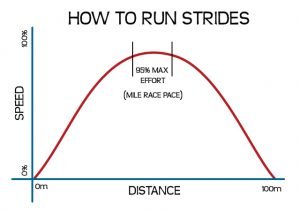Strides for Better Running Technique
What are Strides in Running
Whether you’re an 800m specialist, cross country runner, or an aspiring marathoner, strides are a fundamental building block of speed and coordination.
But the majority of recreational runners never do them despite a host of benefits.
What are strides?
Strides are also known as striders, stride-outs, or accelerations.
They’re about 100m accelerations or around 20 seconds, where you start at a jog, build to about 95% of your max speed, and then gradually slow to a stop. One stride should take you about 20-30 seconds depending on your ability.
Why Should I Try Running Strides?
The ultimate goal of running strides is to increase your stride length while maintaining a quick turnover, or cadence.
Although they may sound tricky or complicated they really arent!
But here’s a short list to get you excited about running strides:
- They help you loosen up after a slow distance run
- Strides serve as a transition to faster workouts – especially for beginners learning how to start running
- They increase your running economy by reinforcing proper running form (i.e., they make you more efficient)
- When done barefoot, they develop foot and lower leg strength with only a small risk of injury
- They metabolically prepare you to run fast before a race or hard workout
- They only take a few minutes

When should I run strides?
Strides are best incorporated in two different situations:
- After an easy or base run. In this scenario, think of strides as a dynamic stretch. They help increase your range of motion, work on your turnover, and subtly improve your form. By shaking out some of the tightness you might feel after miles of running at the same pace, strides can help you feel better for your next run.
- Before a workout or race. Here, strides prepare your body to run fast. They serve as your transition to sustained, harder running.
In either situation, strides should be run at about the same distance and pace. It’s rare to change how a stride is executed.
But rules are meant to be broken! If you’re preparing for a very short, fast race like a mile on the track or 800m, you may want to do shorter, faster strides. They’ll do a better job of opening up your range of motion and metabolically priming you for running really fast.
And the opposite holds true as well: if you’re running a marathon, a few longer, slower strides can help you warm up properly. These can be embedded in a 5-10 minute pre-marathon warm up run.
